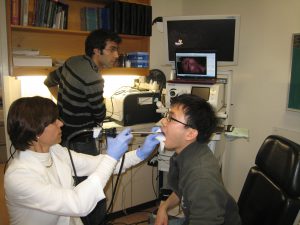
By Alayne Moody
While accepting the first of her six awards on Grammy night 2012, the British singer Adele thanked the co-writer of the winning song “Someone like you,” and then she thanked the surgeons who saved her voice.
An interdisciplinary research effort at McGill, led by engineering professor Luc Mongeau and laryngologist/head-and-neck surgeon Dr. Karen Kost, aims to improve the type of surgery that has helped Adele and many other people suffering from vocal cord injury and disease.
“The larynx is a precisely engineered organ which requires optimum conditioning for peak performance,” says Dr. Karen Kost, the director of the McGill University Health Centre’s Voice and Dysphagia Center at the Montreal General Hospital. “Actors, singers, politicians, ministers, teachers and journalists are all vocal athletes who impose heavy demands on their vocal folds day-in and day-out. As such, they are at risk of developing a number of trauma-related benign lesions on their vocal folds, including polyps and nodules. These affect the delicate structure of the soft tissue on the surface of the vocal cords and interfere with the normal wave, which is necessary for optimal vocal performance. As a result, even subtle changes can significantly compromise sound volume, quality, or both. Our voice is an essential tool, indeed a part of our identity that we rely on from the moment we open our eyes in the morning till we close them at night. A dysphonic or hoarse voice has a huge social and financial impact on anyone who depends on their voice for communication or to earn a living, and that includes pretty much all of us.”
Prof. Luc Mongeau in the Department of Mechanical Engineering is an acoustics specialist who studies sound at many levels, from jet engine noise to the human voice. Early work in voice production resulted in models showing how airflow through the glottis, the opening to the voice box, produces sound. More recent work has looked at novel types of injectable biomaterials that could mediate wound healing after vocal folds surgery, reduce scarring, generate new functional tissue— possibly resulting in faster and better outcomes for musicians like Adele.
Through collaboration with colleagues in the medical disciplines at McGill and elsewhere, Mongeau’s research draws not only on laboratory experiments and computer modeling, but also clinical examinations and procedures as well as biopsies from human subjects and animal models.
“The main goal of the research has always been to restore voice after surgery, identify optimal therapeutic treatments, and also understand, predict and minimize the effects of surgery on the patient’s voice,” Mongeau says. “Developing partnerships with doctors specializing in the diagnosis and treatment of voice disorders was an important, and necessary, move. The synergies were immediately evident.”
“Bringing together engineering and clinical expertise is the way to translate basic bench research into clinical applications with clear benefits to patients,” adds Dr. Kost.
“To predict how vocal fold tissue heals after surgery, we use computer models that treat various inflammation markers and their interactions at the molecular and cell levels as agents,” Mongeau says. “We want to implement these models for execution on graphics processing cards to make them faster and increase their scale. The ultimate goal is to identify the best therapeutic approach for the patient-specific treatment of acute phonotrauma through computer simulations. This is a first step towards personalized medicine, one strategic goal of the National Institutes of Health.”
“Through advanced imaging, such as high-resolution magnetic resonance imaging or computer tomography, along with novel image analysis methods, we want to create computer models of the laryngeal airway that can reproduce the basic phonation processes and act as test beds for virtual surgery or prosthetic and implant design for voice restoration following surgery,” Mongeau says.
New studies will investigate methods for diagnosing vocal cord lesions and laryngeal cancer. With the help of Prof Paul Wiseman in the departments of Chemistry and Physics, the team will compare the molecular composition of healthy and abnormal vocal cord tissue through nonlinear laser microscopy. The goal is to develop a noninvasive technique for identifying vocal cord pathologies in the doctor’s office rather than through surgery and biopsy, which can cause scarring and voice loss.
“Increasingly, advanced technologies are used to solve problems in fields such as cardiology, oncology, and neurology,” Mongeau says. “We try to use state of the art mechanical engineering tools to tackle voice problems. ”
